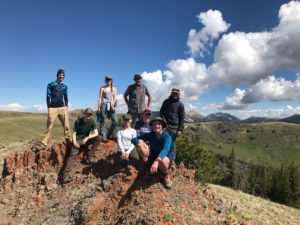
I was up early. It was a cold morning at our camp in a high elevation meadow in the Snowcrest Mountains of Southwestern Montana. I greeted our ever-cheerful instructor Steve and got straight to boiling water for everyone’s breakfast. It was my first time as Leader of the Day, and as I attempted to not cause an explosion with the then-foreign Whisperlite stoves that were perched precariously on largish rocks, I had time to ponder the upcoming hike. I was excited. It was going to be a long trek with lots of off-trail scrambling up and down slopes; however, this wasn’t what excited me. The uphill scrambling was going to take us above the treeline and into the windswept alpine zone of the Snowcrests. I was excited to revel in this lofty landscape and explore the unique fauna and flora that were a stark change from the lodgepole pine- and sagebrush-dominated landscapes of the lower elevations around us. Although I loved the prairie smoke flowers nestled between the sage, I felt the all-to-common feeling that the lower elevation ecosystems were only an appetizer for the alpine ecosystem we were set to explore.
The ridge we traveled along in the Snowcrests undulated along at 10,000 ft. above sea level. Its rocky apex was painted with low-lying grasses and wildflowers. Sky pilots, larkspur, phlox and lanceleaf stonecrop lined the foreground of views that I can only describe with the vague, overused word “inspirational.” I wasn’t necessarily inspired to do anything, but I have a hard time find other words to describe the sensation of “wow, mountains are cool, I like being on top of a huge mound of rock with other large mounds of rock in view.”
Later, towards the end of our course as we hiked up to Dawson Pass in Glacier National Park, we once again broke past the treeline and entered the harsh, beautiful alpine world. However, this time my experience was a bit different. It was still an inspiring landscape that captivated me, but my thinking now involved an understanding that although the alpine landscapes I was able to experience in the Snowcrests, Yellowstone, and Glacier were stunning, it is often the lower landscapes that I brushed off as uninteresting that are most in need of protection. The lush lowland ecosystems that we humans love to populate and utilize harbor much greater biodiversity than the alpine world, yet are often much less protected. Often, areas that humans didn’t settle in and buy up were the lands that Bureau of Land Management lands, National Forests, and Wilderness areas were established in. Consequently, the protected land of the U.S. serves to protect remoteness and not biodiversity.
The under-protection of biodiverse lowlands will only exacerbate the mass extinctions that characterize our Anthropocene Era if it is not addressed. Transitioning our focus to protecting lands that incorporate the importance of diverse ecosystems seems logical to my newfound sensibilities. I believe that implementing traditional land ethics would be helpful in addressing this issue. While on the Blackfeet Nation, I gained understanding of Blackfeet land ethics through reading as well as talking with guest speakers. The knowledge I gained elicited the realization that implementing the way Blackfeet people view the land into our Western environmental ethics would fundamentally change the way we protect our land. Their traditions involve viewing oneself as a caretaker and not an owner of the land. This reciprocal relationship with the land incorporates humans into the ecosystem, as opposed to Western views that often pit humans against nature. While I currently only understand a small portion of Blackfeet traditional ecological knowledge, I am sure that the wisdom of other tribes could only bolster the formation of a new ethic that would help to ameliorate losses of biodiversity. A place-based outlook where humans are simply a part of a localized natural community would allow us to understand the importance of the land where we live and find beauty in it that is just as important—or dare I say more important—than the beauty that my eyes need no coaching to enjoy.
Sam Eberhard is a student at the University of California-Santa Cruz, where he studies Environmental Studies and Biology.